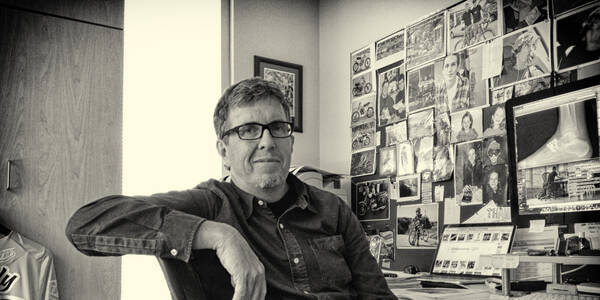
feature / sponsored-projects / interaction-design / environmental-design / transportation-design / product-design / media-design
June 16, 2021
By Evan Henerson
Turn of Events: Reimagining Gatherings for the Post-Pandemic Era
Many years ago, Erick Weiss pitched an idea for a unique and futuristic musical experience that would place attendees in the middle of the action. Imagine James Cameron’s Avatar meets Electric Zoo.
“If you purchased a certain VIP type of ticket, you would get a 3D experience of standing on stage with Britney Spears during the sound check,” said Weiss, the president and founder of the event production company Honeysweet Creative. “We would shoot all of that in 3D and you could stand on stage with her. You could be hanging out backstage or go into the sound booth and watch them mix it while it was happening.”
The idea did not come to fruition; the technology was simply not common enough to make it happen. Now the uses of digital media, including AR and VR have become not just a measure of coolness, but a creative necessity as event production undergoes a COVID-era metamorphosis. As companies all over the world cautiously emerge into the uncertain daylight of a post-pandemic landscape, events as we have known them are becoming a thing of the past.

See how our Sponsored Studios bring students and corporate partners together to create innovative solutions.
Conventions, conferences festivals and expos that have traditionally drawn hundreds of thousands of attendees were forced to pivot to a truncated digital format in 2020 or were canceled entirely with promises of “we’ll be back bigger and better than ever in 2021 once it’s safe.” Organizations with products, services and experiences to market have spent the last year figuring out how to go from “the show must go on” to “the show must go above and beyond.
That’s a challenge when the event that is adapting is already considered a game-changer. Reflecting on Dreamforce, Salesforce’s annual B2B tech conference that traditionally takes over San Francisco for four days every September, Salesforce Vice President and Executive Creative Director of Events and Experiences David Lentz notes that Dreamforce-goers feel like they are at an amusement park.
“The fanaticism of the attendees at Dreamforce is unmatched. We see grown adults turn into almost like a child version of themselves, they’re so excited,” said Lentz. “The environment we create is so stimulating it really does feel like an immersive Disney experience, but also just the amount of content information and experience we afford them for the price of admission, I don’t think anybody delivers on the same level.”
With the pandemic making an in person event impossible, the conference’s 2020 incarnation morphed into the virtual Dreamforce to You which offered a series of events over six weeks. The event will continue to evolve in 2021 and beyond, and a group of ArtCenter College of Design students may have a hand in the new vision … or at the very least in some extremely creative brainstorming sessions.
Teams of students in the two ArtCenter Sponsored Studios have spent the spring semester tackling the question of what these new events will look like. Working in partnership with high-level executives from Salesforce and the auto maker Genesis, the teams of ArtCenter students have presented high-level experiential design concepts that the companies have the option to purchase and bring to life.
“Our position is that if the students can create something that is feasible, Genesis is willing to build it, make it come to life, take it around and see how it works and put it somewhere where people can interact with it,” said John Krsteski, Genesis Chief Designer. “Even if the idea is too conceptual, I’m sure there are things we can be inspired from it.”
As anybody who has ever tackled a huge creative challenge will tell you, unleashing your mind and giving yourself license to dream big is not as easy as it sounds. The students, whose majors span the disciplines of environmental design, transportation design, product design, interactive design, graphic design and media design practice, had to consider issues of cost, audience interest and feasibility. To make things even more interesting, the students were themselves restricted by limitations placed on them by the pandemic. Teams, whose members were located in different countries, would assemble and present their ideas via Zoom.
The distance learning circumstance may have even helped them gain a window into the minds of the very event-goers they were targeting, said Adjunct Associate Professor of Graduate and Undergraduate Environmental Design Michael Neumayr (BS 91 Product).
“It’s unbounded thinking, but it’s founded in a strong understanding of the human condition and the condition that we are all in right now,” said Neumayr who taught the Sponsored Studios class with Salesforce. “The success of the project is understanding the human component that connects everything.”
Indeed, it was tapping into the human experience that made the ArtCenter presentations so imaginative and remarkable, said Salesforce team members who saw project concepts evolve. Students brought in ideas for gaming, mixed reality and choose-your-own adventure and the use of non-fungible tokens (NFT). They proposed ways that Dreamforce could be taken around the world and incorporate elements that focus on the importance of sustainability. At the midterm stage, one of the ideas earned a Zoom standing ovation from the Salesforce team members.
“Community engagement is super important and as a company, we want to make sure our audience is empowered and knows what we’re doing,” said Domenique Sillett Buxton, VP Executive Creative Director, Trailhead for Salesforce. “I really appreciated that the students thought not only about the event itself, but about what happens before and after the event. There was a real feeling of action to take and for people to feel like they had an experience not only to remember, but to act upon.”

Nonprofits face similar challenges. In converting its annual BRIC Summit from a 150-member in person event to a digital gathering, the leaders of the BRIC Foundation used the film festival platform Filmocracy to create a summit that essentially had three events going simultaneously. The goal, as with in person events, is to provide a space for people throughout the industry to discuss issues of diversity and inclusion.
“Our summit was initially built and innovated as panels and workshops and people from government to educators to live action, animation and VFX would share perspectives,” said Alison Mann, BRIC Foundation CEO. “You lose a little bit of the intimacy when you go digital, but I found that we ended up with a lot of great insight. It was just communicated a bit differently.”
On the most practical level, the students in Marek Djordjevic’s (BS 91 Transportation) and Cory Grosser’s (BS 01 Environmental) sponsored studio with Genesis were confronted with the task of designing new luxury vehicles, but also with figuring out a way to showcase them safely and innovatively to potential consumers. The event may need to be replicated. How many people can come in? How does it need to be staffed?
“Although all of the students involved are creative, due to their different disciplines they each look at things with completely different eyes and think differently,” said Djordjevic. “There may be differences in specific considerations regarding the design of the vehicle or the environment, but they all share in the need to employ empathy towards the potential customer. Challenging projects like this provide a tremendous opportunity for unique results as well as offer to our students the benefit of learning from each other.”

The question underscores the type of conundrum that Honeysweet Creative’s Weiss has been facing as he has worked to promote events during the pandemic. Many people instinctively believe that there is no acceptable substitute for a live event.
Weiss, who often works with clients in the entertainment industry, has seen and worked his share of live Zoom events as well as those that are both live on Zoom and also using pre-recorded video. He has seen corporate companies and nonprofits use platforms to create virtual trade shows that allow the attendee to move to vendor booths and ask questions or get information along the way.
Award shows are a different animal. In producing the annual Make Up and Hair Stylists Guild Awards (MUAHs) in April, Weiss and his team created a fully broadcast show, a move that required figuring out some variables and taking some creative risks. With multiple celebrities making guest appearances and large numbers of nominees in each category, the Honeysweet team figured out a way to give all 300 nominees screen time and to let them all find out live who won. The company TVU Networks helped assemble a combination of hardware and cloud computing. In the end, the MUAHs needed nine devices to help corral the 300 honorees.
“Nobody had done that before. We broke the mold to make that happen,” said Weiss. “There are a lot of moving parts to a live event, but at the end of the day, it’s a live event. With this kind of thing where you’re pre-producing so much of it, it’s really got to be pretty slick and look pretty perfect.”
With the health landscape still uncertain for the foreseeable future, most event organizers predict that all major events will be a hybridized combination of in person and digital. This is both out of a concern for participant safety and to expand the audience base. Whether new ideas are hatched by high level professional design think tanks or in a classroom at Art Center, all dreams are welcome.
“We used to talk about ‘some day in the future,’” said Salesforce’s Buxton. “Now let’s just stop and say ‘The future is here.’”




